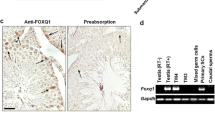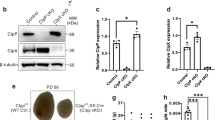Abstract
Lactate is a key metabolite for the normal occurrence of spermatogenesis. In the testis, lactate is produced by the Sertoli cells and transported to germline cells. Monocarboxylate transporters (MCTs) are key players in that process. Among the family of MCTs, MCT1 is at least partly responsible for lactate uptake by the germ cells. We aimed to perform a first assessment of the role of MCT1 in male reproductive potential. Mct1 conditional knockout (cKO) mice were used for morphometric evaluation, testicular morphology, and sperm parameter assessment. Serum steroid hormones levels were also measured. cKO animals showed a decrease in gonadosomatic index, testis weight, and seminiferous tubular diameters. Deletion of MCT1 also causes morphological changes in the organization of the seminiferous tubules and on Sertoli cell morphology. These changes resulted in failure of spermatogenesis with depletion of germ cells and total absence of spermatozoa. MCT1 cKO animals presented also hormonal dysregulation, with a decrease in serum 17β-estradiol levels. In conclusion, MCT1 is pivotal for male reproductive potential. Absence of MCT1 results in maintenance of undifferentiated spermatogonia pool and compromised sperm production.


Similar content being viewed by others
References
Agarwal A, Mulgund A, Hamada A, Chyatte MR (2015) A unique view on male infertility around the globe. Reprod Biol Endocrinol 13:37
Barratt CL, De Jonge CJ, Sharpe RM (2018) Man up’: the importance and strategy for placing male reproductive health centre stage in the political and research agenda. Hum Reprod 33:541–545
Bernardino RL, Martins AD, Jesus TT, Sá R, Sousa M, Alves MG, Oliveira PF (2015) Estrogenic regulation of bicarbonate transporters from SLC4 family in rat Sertoli cells. Mol Cell Biochem 408:47–54
Bernardino RL, Costa AR, Martins AD, Silva J, Barros A, Sousa M, Sá R, Alves MG, Oliveira PF (2016) Estradiol modulates Na+-dependent HCO3− transporters altering intracellular pH and ion transport in human Sertoli cells: a role on male fertility? Biol Cell 108:179–188
Bonen A (2001) The expression of lactate transporters (MCT1 and MCT4) in heart and muscle. Eur J Appl Physiol 86:6–11
Boussouar F, Benahmed M (2004) Lactate and energy metabolism in male germ cells. Trends Endocrinol Metab 15:345–350
Brauchi S, Rauch MC, Alfaro IE, Cea C, Concha II, Benos DJ, Reyes JG (2005) Kinetics, molecular basis, and differentiation of L-lactate transport in spermatogenic cells. Am J Physiol Cell Physiol 288:C523–C534
Cardiff RD, Miller CH, Munn RJ (2014) Manual hematoxylin and eosin staining of mouse tissue sections. Cold Spring Harb Protoc 2014:655–658
Carreau S, Papadopoulos V, Drosdowsky M (1988) Stimulation of adult rat Leydig cell aromatase activity by a Sertoli cell factor. Endocrinology 122:1103–1109
Correia S, Alves MR, Martins AD, Cavaco JE, Oliveira PF, Socorro S (2014) Effect of 17 [beta]-estradiol on germ cell apoptosis by modulating the expression of SCF/c-kit, FasL/FasR and regucalcin. Endocr Abstr 35:P702
Correia S, Cardoso HJ, Cavaco JE, Socorro S (2015) Oestrogens as apoptosis regulators in mammalian testis: angels or devils? Expert Rev Mol Med 17:e2
Dias TR, Martins AD, Reis VP, Socorro S, Silva BM, Alves MG, Oliveira PF (2013) Glucose transport and metabolism in Sertoli cell: relevance for male fertility. Curr Chem Biol 7:282–293
Draoui N, Feron O (2011) Lactate shuttles at a glance: from physiological paradigms to anti-cancer treatments. Dis Model Mech 4:727–732
Ebling FJ, Brooks AN, Cronin AS, Ford H, Kerr JB (2000) Estrogenic induction of spermatogenesis in the hypogonadal mouse. Endocrinology 141:2861–2869
Eid N, Ito Y, Otsuki Y (2012) Enhanced mitophagy in Sertoli cells of ethanol-treated rats: morphological evidence and clinical relevance. J Mol Histol 43:71–80
Erkkilä K, Aito H, Aalto K, Pentikäinen V, Dunkel L (2002) Lactate inhibits germ cell apoptosis in the human testis. Mol Hum Reprod 8:109–117
Galardo MN, Riera MF, Pellizzari EH, Cigorraga SB, Meroni SB (2007) The AMP-activated protein kinase activator, 5-aminoimidazole-4-carboxamide-1-bD-ribonucleoside, regulates lactate production in rat Sertoli cells. J Mol Endocrinol 39:279–288
Grootegoed J, Den Boer P (1990) Energy metabolism of spermatids: a review. In: Hamilton DW, Waites GMH (eds) WHO Special Programme of Research, Development and Research Training in Human Reproduction & Family Health International. Cellular and molecular events in spermiogenesis: proceedings of a symposium held at Oaxtepec, Mexico, 11–13 March 1987 / edited by D. W. Hamilton, G. M. H. Waites. University Press, Cambridge
Halestrap AP, Price NT (1999) The proton-linked monocarboxylate transporter (MCT) family: structure, function and regulation. Biochem J 343:281
Kumar N, Singh AK (2015) Trends of male factor infertility, an important cause of infertility: a review of literature. J Hum Reprod Sci 8:191–196
Lambard S, Silandre D, Delalande C, Denis-Galeraud I, Bourguiba S, Carreau S (2005) Aromatase in testis: expression and role in male reproduction. J Steroid Biochem Mol Biol 95:63–69
Lardone M, Argandona F, Florez M, Parada-Bustamante A, Ebensperger M, Palma C, Piottante A, Castro A (2017) Overexpression of CYP19A1 aromatase in L eydig cells is associated with steroidogenic dysfunction in subjects with Sertoli cell-only syndrome. Andrology 5:41–48
Levine H, Jørgensen N, Martino-Andrade A, Mendiola J, Weksler-Derri D, Mindlis I, Pinotti R, Swan SH (2017) Temporal trends in sperm count: a systematic review and meta-regression analysis. Hum Reprod Update 23:646–659
Mannowetz N, Wandernoth P, Wennemuth G (2012) Basigin interacts with both MCT1 and MCT2 in murine spermatozoa. J Cell Physiol 227:2154–2162
Martin JA, Hamilton BE, Sutton PD, Ventura SJ, Menacker F, Kirmeyer S, Munson ML (2007) Births: final data for 2005. Natl Vital Stat Rep 56:1–103
Nakai M, Chen L, Nowak RA (2006) Tissue distribution of basigin and monocarboxylate transporter 1 in the adult male mouse: a study using the wild-type and basigin gene knockout mice. Anat Rec A Discov Mol Cell Evol Biol 288:527–535
Nitta H, Bunick D, Hess R, Janulis L, Newton SC, Millette CF, Osawa Y, Shizuta Y, Toda K, Bahr JM (1993) Germ cells of the mouse testis express P450 aromatase. Endocrinology 132:1396–1401
Oliveira P, Alves M, Rato L, Silva J, Sa R, Barros A, Sousa M, Carvalho R, Cavaco J, Socorro S (2011) Influence of 5α-dihydrotestosterone and 17β-estradiol on human Sertoli cells metabolism. Int J Androl 34:612–620
Oliveira P, Alves M, Rato L, Laurentino S, Silva J, Sa R, Barros A, Sousa M, Carvalho R, Cavaco J (2012) Effect of insulin deprivation on metabolism and metabolism-associated gene transcript levels of in vitro cultured human Sertoli cells. Biochim Biophys Acta Gen Subj 1820:84–89
Oliveira PF, Martins AD, Moreira AC, Cheng CY, Alves MG (2015) The Warburg effect revisited—lesson from the Sertoli cell. Med Res Rev 35:126–151
Poole RC, Halestrap AP (1993) Transport of lactate and other monocarboxylates across mammalian plasma membranes. Am J Phys Cell Phys 264:C761–C782
Rato L, Alves MG, Socorro S, Carvalho RA, Cavaco JE, Oliveira PF (2012) Metabolic modulation induced by oestradiol and DHT in immature rat Sertoli cells cultured in vitro. Biosci Rep 32:61–69
Rato L, Alves M, Dias T, Lopes G, Cavaco J, Socorro S, Oliveira P (2013) High-energy diets may induce a pre-diabetic state altering testicular glycolytic metabolic profile and male reproductive parameters. Andrology 1:495–504
Russell LD, Ettlin RA, Hikim APS, Clegg ED (1993) Histological and histopathological evaluation of the testis. Int J Androl 16:83–83
Sharpe RM (2010) Environmental/lifestyle effects on spermatogenesis. Philos Trans R Soc Lond Ser B Biol Sci 365:1697–1712
Acknowledgments
The authors are thankful to Ângela Alves for the technical support.
Funding
This work was supported by “Fundação para a Ciência e a Tecnologia” (FCT) to Raquel L. Bernardino (SFRH/BD/103105/2014) and Tânia R. Dias (SFRH/BD/109284/2015). The work was co-funded by FEDER through the COMPETE/QREN, FSE/POPH to Marco G. Alves (PTDC/BIM-MET/4712/2014 and PTDC/MEC-AND/28691/2017); Pedro F. Oliveira (PTDC/BBB-BQB/1368/2014); UMIB (PEst-OE/SAU/UI0215/2014); co-funded by the EU Framework Programme for Research and Innovation H2020 (POCI/COMPETE2020).
Author information
Authors and Affiliations
Corresponding author
Ethics declarations
Conflict of interest
The authors declare that there are no conflicts of interest.
Ethical approval
All applicable international, national, and/or institutional guidelines for the care and use of animals were followed. This article does not contain any studies with human participants performed by any of the authors.
Informed consent
Not applicable.
Additional information
Publisher’s note
Springer Nature remains neutral with regard to jurisdictional claims in published maps and institutional affiliations.
Electronic supplementary material
Figure 3
Murine Mct1 exon 4 was flanked by loxP sites with adjoining upstream and downstream sequences of the mouse Mct1 genomic locus. Positive (Neomycin) and negative (Herpes simplex virus thymidine kinase) selectable markers were incorporated into the targeting vector for selection during homologous recombination in mouse embryonic stem (ES) cells. Genomic southern and PCR were used to detect correctly targeted mouse ES cells. (PNG 1671 kb)
Rights and permissions
About this article
Cite this article
Bernardino, R.L., D’Souza, W.N., Rato, L. et al. Knockout of MCT1 results in total absence of spermatozoa, sex hormones dysregulation, and morphological alterations in the testicular tissue. Cell Tissue Res 378, 333–339 (2019). https://doi.org/10.1007/s00441-019-03028-4
Received:
Accepted:
Published:
Issue Date:
DOI: https://doi.org/10.1007/s00441-019-03028-4




